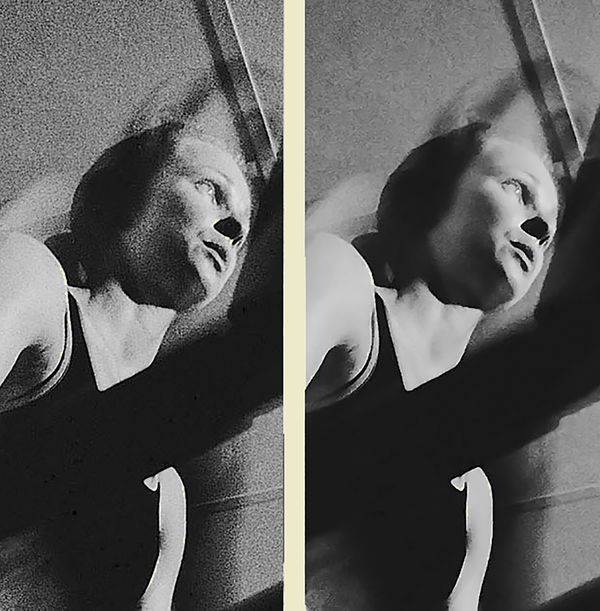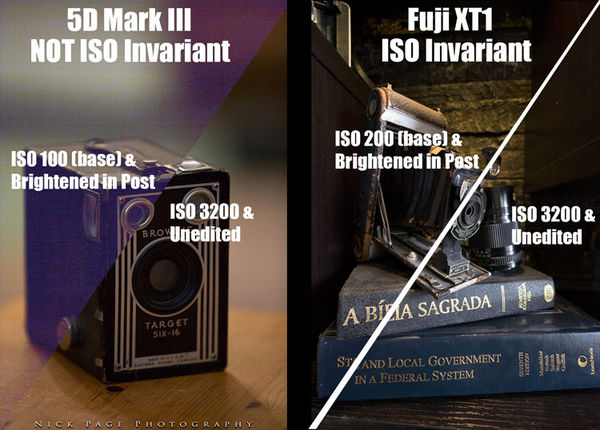Why high ISO?
Dec 9, 2017 19:56:06 #
[quote=Gene51]RGG - I don't think anyone here understands the concept of ISO invariance...
Gene, please don’t include me in your blanket statement - I understand it just fine (and I suspect that others do as well), although I can see that some don’t including some of those that endorse it as universally useful for all cameras in all situations. My point was/is that the practice, while applicable to some cameras, especially Nikon’s and perhaps Sonys, isn’t applicable to all cameras, especially many Canons among others (which make up a pretty sizable percentage of both amateur and pro cameras in use). Perhaps the resistance you and Ron are encountering from some users isn’t their lack of understanding, but the fact that they do, in fact understand exactly how their particular camera responds to underexposure and bringing up in post.
Gene, please don’t include me in your blanket statement - I understand it just fine (and I suspect that others do as well), although I can see that some don’t including some of those that endorse it as universally useful for all cameras in all situations. My point was/is that the practice, while applicable to some cameras, especially Nikon’s and perhaps Sonys, isn’t applicable to all cameras, especially many Canons among others (which make up a pretty sizable percentage of both amateur and pro cameras in use). Perhaps the resistance you and Ron are encountering from some users isn’t their lack of understanding, but the fact that they do, in fact understand exactly how their particular camera responds to underexposure and bringing up in post.
Dec 9, 2017 19:59:43 #
CHG_CANON wrote:
I couldn't get any slower than 1/60 on a moving target still at ISO-5000 ....
Canvasback by Paul Sager on 500px.com
http://drscdn.500px.org/photo/234453427/m%3D900/v2?user_id=8097963&webp=true&sig=9f5955732054d29472846edb57b8a126db38c225136baa72e2641970b9eaa7ff
Canvasback by Paul Sager on 500px.com
http://drscdn.500px.org/photo/234453427/m%3D900/v2?user_id=8097963&webp=true&sig=9f5955732054d29472846edb57b8a126db38c225136baa72e2641970b9eaa7ff
beautiful picture--i was afraid of going too high on iso , but your'e duck proves quality can be had,im gonna try it.again beautiful capture

Dec 9, 2017 20:16:02 #
lukevaliant wrote:
beautiful picture--i was afraid of going too high on iso , but your'e duck proves quality can be had,im gonna try it.again beautiful capture 

Thanks Luke! Sometimes, a picture is worth a thousand words about high ISO opportunities ...
Dec 9, 2017 20:30:43 #
Your Expectations are Way to high for a camera. Visit 500PX or any other high quality photo site and see how many Killer captures fall within your ISO range......It's in the capture, not the camera.
Rongnongno wrote:
Err, no where do I mention ISO 100 as a reference. I use 'Base ISO' which varies depending on the camera used.
Please note that the DR exploitation is available only with the new crop of cameras that use invariant sensors.
Please note that the DR exploitation is available only with the new crop of cameras that use invariant sensors.
Dec 9, 2017 21:45:49 #
Dec 9, 2017 22:56:09 #
there just are times when you need more speed. sometimes it's to get the shot. sometimes we use it to make a remarkable shot. there's always been a desire for more speed. in the 60's and 70's it was asa 200 and 400. then it was push processing, always a desire for more speed. we can always find a reason for it.
Dec 9, 2017 23:25:35 #
If your camera captures noise like the detail on the left, no single noise reduction program will get you to the image on the right. It took several different time-consuming noise reduction methods to make this a usable pic. Not a fun job in post.
Fotoartist wrote:
No. In dynamic range tests that I have seen the D4s actually does better at ISO 400 than its native ISO 200. So native ISO doesn't mean that much as a goal to strive for. But I will not be so quick in jettisoning my underexposed shots anymore.

Dec 10, 2017 01:18:38 #
[quote=TriX]
Pentax too seems well able too, perhaps it's more a feature of the Sony Sensors.
Gene51 wrote:
RGG - I don't think anyone here understands the co... (show quote)
Pentax too seems well able too, perhaps it's more a feature of the Sony Sensors.
Dec 10, 2017 05:29:56 #
blackest wrote:
Pentax too seems well able too, perhaps it's more a feature of the Sony Sensors.
There are some Pentax and Fuji and Olympus that are - I think we'll be seeing more.
Dec 10, 2017 05:34:29 #
Fotoartist wrote:
If your camera captures noise like the detail on the left, no single noise reduction program will get you to the image on the right. It took several different time-consuming noise reduction methods to make this a usable pic. Not a fun job in post.
The camera you used is clearly not ISO invariant. Below there is a comparison between one popular camera that isn't (Canon 5d k III) and one that is (Fuji XT1).
https://improvephotography.com/34818/iso-invariance/
My D810 is, and it is no problem recovering from 5 stops of underexposure by simply adjusting the exposure, shadow and contrast sliders in Lightroom.
A picture is worth a 1000 words.
.
.
Dec 10, 2017 05:36:58 #
bull drink water wrote:
there just are times when you need more speed. sometimes it's to get the shot. sometimes we use it to make a remarkable shot. there's always been a desire for more speed. in the 60's and 70's it was asa 200 and 400. then it was push processing, always a desire for more speed. we can always find a reason for it.
Yes, and ISO invariant cameras let you underexpose - use a faster shutter speed - without needing to change the ISO. BTW, using an ISO that is higher than the base ISO is not changing the camera's sensitivity to light, it is just turning up the gain on the image signal - as well as the noise. ISO invariant cameras let you do that in software.
Dec 10, 2017 05:38:19 #
[quote=TriX]
Ok - You are excluded
A generalization is nothing but a broad statement that applies to many. Like all cats love catnip. Generalizations are seldom true for all cases. Exceptions like yourself are a great example.
I totally agree. But when someone states I can't shoot at low ISO because I need a smaller lens opening or a shorter shutter speed to "catch the action" that clearly indicates a lack of understanding of ISO Invariance. Right now there are just a handful of cameras that can be considered ISO invariant.
Gene51 wrote:
RGG - I don't think anyone here understands the co... (show quote)
Ok - You are excluded

A generalization is nothing but a broad statement that applies to many. Like all cats love catnip. Generalizations are seldom true for all cases. Exceptions like yourself are a great example.
I totally agree. But when someone states I can't shoot at low ISO because I need a smaller lens opening or a shorter shutter speed to "catch the action" that clearly indicates a lack of understanding of ISO Invariance. Right now there are just a handful of cameras that can be considered ISO invariant.
Dec 10, 2017 06:45:52 #
rehess wrote:
Are you saying that D850 is ISO invariant? If that is so wonderful, why do they allow users to change ISO?
Think about your question for a moment. The premise is that you can underexpose up to 5 stops at base ISO without negatively impacting the image. If you need to go higher, you can always increase the ISO. Or if you don't understand the concept. Either way, Nikon (and others) give you the option.
Dec 10, 2017 06:49:29 #
chrisg-optical wrote:
As you can see from other posts its out of necessity rather than choice in most cases.....but you always should shoot at the lowest ISO possible when conditions allow. Lately ive been shooting with auto ISO, max 6400, manual mode to lock in desired shutter/fstop combo on my D7200.
And with your D7200, which is ISO invariant, if your conventional exposure settings suggest F8 at 1/250 second at ISO 3200, you could set your camera to ISO 100 and not have to worry about the 5 stops of underexposure. If you try that with a non invariant camera - good luck recovering.
Dec 10, 2017 06:54:43 #
TriX wrote:
There are many moving subject, low light situations where flash isn’t appropriate including performances, night/indoor weddings, indoor sports, etc. that require relatively high shutter speed to freeze the motion, which even with fast lenses requires high ISO.
I just re-read this in light of not wanting to be included in my broad generalization.
Well, when you say that "even with fast lenses requires high ISO" seems to imply that you are not at all familar with ISO invariance. Once again - with an ISO invariant camera you can set the camera as you need to - for stopping action or increasing depth of field - and if you stay within 5 stops (or so) if base ISO, you will not do any better at the "correct" ISO than if you had set it to base ISO and kept your settings as you need them to be. And because you are not even close to blowing out highlights, you will likely end up with greater dynamic range.
If you want to reply, then register here. Registration is free and your account is created instantly, so you can post right away.









